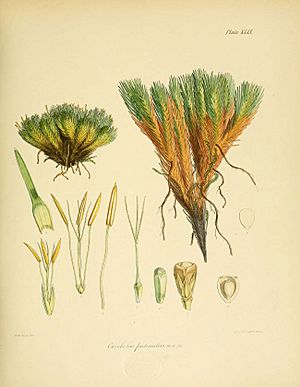Oreobolus pectinatus facts for kids
Quick facts for kids Oreobolus pectinatus |
|
|---|---|
 |
|
| Plate XLIX | |
| Scientific classification | |
| Genus: |
Oreobolus
|
| Species: |
pectinatus
|
| Synonyms | |
|
Oreobolus pumilio var. pectinatus (Hook.f.) C.B.Clarke ex Cheeseman Oreobolus serrulata Colenso |
|
Oreobolus pectinatus (also known as Comb sedge, cushion sedge, or flat-leaved comb sedge) is a cool flowering plant that belongs to the sedge family. It's found in the subantarctic islands and in both the North and South Islands of New Zealand. Its scientific name, pectinatus, comes from a Latin word meaning "comb-shaped." This is because its leaves look a bit like a comb!
Contents
What it Looks Like
Oreobolus pectinatus is a plant that lives for many years. It grows in thick, dense clumps that are usually 10 to 100 millimeters (about 0.4 to 4 inches) tall. Its stems are packed closely together and have many branches at the bottom, covered with leaves.
Leaves and Stems
The leaves have a main vein and two side veins that you can see easily. On the top surface of the leaf, only the main vein stands out. Both sides of the leaf have many tiny pores called stomata, which help the plant "breathe." The bottom part of the leaf, called the sheath, wraps around the stem and has 5 to 7 veins.
Flowers and Fruit
The plant usually has single flower clusters called spikelets. The stalk that holds the mature flower is typically longer than the leaves. Each flower usually has three protective leaf-like parts called glumes, but sometimes there can be four. The fourth glume is usually smaller.
The fruit of the plant is a small nut. When it first forms, it has no color. But as it ripens, it turns a reddish-brown color, almost black. It's very tiny, usually a bit more than 1 millimeter long and less than 1 millimeter wide.
Life Cycle
This plant flowers from October to December. Its fruits develop and ripen from November to April.
Where it Lives
You can find Oreobolus pectinatus on New Zealand's Antipodes Islands, and on the North and South Islands of New Zealand.
Habitat and Environment
This plant grows in different places, from coastal areas all the way up to mountains. It can be found as high as 1500 meters (about 4900 feet) above sea level. However, in the southern part of the South Island and on Stewart, Auckland, and Campbell Islands, it can grow right at sea level. It's very common in wet, spongy areas like cushion bogs, alpine seepages (where water slowly seeps out of the ground), and mires (another type of wetland).
Conservation Status
Good news! Oreobolus pectinatus is doing well. In 2009, 2012, and again in 2018, experts in New Zealand decided it was "Not Threatened." This means it's not currently at risk of disappearing.

